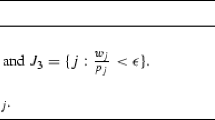Abstract
A version of weighted coloring of a graph is introduced which is motivated by some types of scheduling problems: each node v of a graph G corresponds to some operation to be processed (with a processing time w(v)), edges represent nonsimultaneity requirements (incompatibilities). We have to assign each operation to one time slot in such a way that in each time slot, all operations assigned to this slot are compatible; the length of a time slot will be the maximum of the processing times of its operations. The number k of time slots to be used has to be determined as well. So, we have to find a k-coloring \({\cal S}\)= \(({S_{1},\ldots ,S_{k}})\) of G such that w(S 1) + ⋅s +w(S k ) is minimized where w(S i ) = max {w(v) :v∊V}. Properties of optimal solutions are discussed, and complexity and approximability results are presented. Heuristic methods are given for establishing some of these results. The associated decision problems are shown to be NP-complete for bipartite graphs, for line-graphs of bipartite graphs, and for split graphs.
Similar content being viewed by others
Explore related subjects
Discover the latest articles, news and stories from top researchers in related subjects.References
Alfandari, L. and V. T. Paschos, “Master–slave strategy and polynomial approximation,” Computational Optimization and Applications, 16, 231–245 (2000).
Bar-Noy, A., M. Bellare, M. M. Halldórsson, H. Shachnai, and T. Tamir, “On chromatic sums and distributed resource allocation,” Information and Computation, 140, 183–202 (1988).
Berge, C., Graphs and Hypergraphs. North Holland, Amsterdam, 1973.
Blazewicz, J., K. H. Ecker, E. Pesch, G. Schmidt, and J. Weglarz, Scheduling Computer and Manufacturing Processes. Springer Verlag, Berlin (1996).
Bodlaender, H. L., K. Jansen, and G. J. Woeginger, “Scheduling with incompatible jobs,” Discrete Applied Mathematics, 55, 219–232 (1994).
Boppana, B. B. and M. M. Halldórsson, “Approximating maximum independent sets by excluding subgraphs,” BIT, 32(2), 180–196 (1992).
Boudhar, M. and G. Finke, “Scheduling on a batch machine with job compatibilities,” Special issue ORBEL-14: Emerging challenges in operations research (Mons, 2000). Belgian Journal of Operational Research Statistical Computer Science, 40(1–2), 69–80 (2000).
Brandstädt, A., V. B. Le, and J. P. Spinrad, Graph Classes: A Survey, SIAM Monographs on Discrete Mathematics and Applications (1999).
Burkard, R. E., “Time-slot assignment for TDMA-systems,” Computing, 35, 99–112 (1985).
Chvàtal, V., “Perfectly ordered graphs,” in C. Berge and V. Chvàtal (Eds.), Topics on Perfect Graphs, volume 21 of Annals of Discrete Math. (1984) pp. 253–277.
Cook, W. J., W. H. Cunningham, W. R. Pulleyblank, and A. Schrijver, Combinatorial Optimization. J. Wiley, 1998.
de Werra, D., “On some combinatorial problems arising in scheduling,” Canad. Operational Research Society Journal, 8, 165–175 (1970).
de Werra, D., “Heuristics for graph coloring,” Computing, 7, 191–208 (1990).
de Werra, D. and J. Erschler, “Open shop scheduling with some additional constraints,” Graphs and Combinatorics, 12, 81–93 (1996).
de Werra, D. and Y. Gay, “Chromatic scheduling and frequency assignment,” Discrete Applied Mathematics, 49, 165–174 (1994).
Fiala, J. The NP-completeness of the edge precoloring extension problem on bipartite graphs. Unpublished result.
Garey, M. R. and D. S. Johnson, “Complexity results for multiprocessor scheduling under resource constraints,” SIAM Journal on Computing, 4, 397–411 (1975).
Gerke, S., “Colouring weighted bipartite graphs with a co-site constraint,” Discrete Mathematics, 224, 125–138 (2000).
Golumbic, M. C. Algorithmic Graph Theory and Perfect Graphs. Academic Press, New York (1980).
Holyer, I., “The NP-completeness of edge-colouring,” SIAM Journal on Computing, 10, 718–720 (1981).
Jansen, K., “Approximation results for the optimum cost chromatic partition problem,” in P. M. Pardalos and D. Du (Eds.), Theoretical Computer Science, Network Design: Connectivity and Facilities Location (1997) pp. 143–168.
Jansen, K. and P. Scheffler, “Generalized coloring for tree-like graphs,” Discrete Applied Mathematics, 75, 135–155 (1997).
Johnson, D. S., “Approximation algorithms for combinatorial problems,” Journal of Computer and System Sciences, 9, 256–278 (1974).
Karp, R. M., “Reducibility among combinatorial problems,” in R. E. Miller and J. W. Thatcher (Eds.), Complexity of Computer Computations, Plenum Press, New York (1972) pp. 85–103.
König, D., “Über graphen und iher anwendung auf determinantentheorie und mengenlehre,” Annals of Mathematics, 77, 453–465 (1916).
Nicoloso, S., M. Sarrafzadeh, and X. Song, “On the sum coloring problem on interval graphs,” Algorithmica, 23, 109–126 (1999).
Potts, C. N. and M. Y. Kovalyov, “Scheduling with batching: a review,” European Journal of Operational Research, 120, 228–249 (2000).
Potts, C. N., V. A. Strusevich, and T. Tautenhahn, “Scheduling batches with simultaneous job processing for two-machine shop problems,” Journal of Scheduling, 4, 25–51 (2001).
Rendl, F., “On the complexity of decomposing matrices arising in satellite communication,” Operations Research Letters, 4, 5–8 (1985).
Simon, H. U., “On approximate solutions for combinatorial optimization problems,” SIAM Journal on Discrete Mathematics, 3(2), 294–310 (1990).
Tuza, Z., “Graph colorings with local constraints-a survey,” Discussiones Mathematicae Graph Theory, 17, 161–228 (1997).
Author information
Authors and Affiliations
Corresponding author
Rights and permissions
About this article
Cite this article
Demange, M., Werra, D.d., Monnot, J. et al. Time slot scheduling of compatible jobs. J Sched 10, 111–127 (2007). https://doi.org/10.1007/s10951-006-0003-7
Published:
Issue Date:
DOI: https://doi.org/10.1007/s10951-006-0003-7




